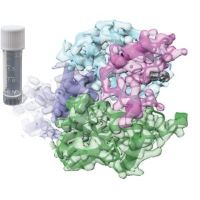Specification
| Description | Recombinant protein from the full-length sequence of Homo sapiens C-X-C motif chemokine ligand 12 (CXCL12), transcript variant 1 (NM_199168). |
| Organism | Homo sapiens (Human) |
| Expression Host | Human Cells |
| Tag Info | His or DYKDDDDK. Please contact us if you need further information or require specific designed tag. |
| Purity | Greater than 90% by SDS-PAGE gel |
| Uniprot ID | P48061 |
| Entry Name | SDF1_HUMAN |
| Gene Names | CXCL12 SDF1 SDF1A SDF1B |
| Alternative Gene Names | SDF1 SDF1A SDF1B |
| Alternative Protein Names | Stromal cell-derived factor 1 (SDF-1) (hSDF-1) (C-X-C motif chemokine 12) (Intercrine reduced in hepatomas) (IRH) (hIRH) (Pre-B cell growth-stimulating factor) (PBSF) [Cleaved into: SDF-1-beta(3-72); SDF-1-alpha(3-67)] |
| Application | Antigens, Western, ELISA and other in vitro binding or in vivo functional assays, and protein-protein interaction studies; For research & development use only! |
| Buffer | Purified protein formulated in a sterile solution of PBS buffer, pH7.2, without any preservatives |
| Endotoxin | Endotoxin level is < 0.1 ng/µg of protein (<1EU /µg) |
| Length | 93 |
| Molecular Weight(Da) | 10666 |
| Protein Sequence | (The sequence of expressed protein may have some variation from the sequence shown below. Please contact us for the exact sequence.) MNAKVVVVLVLVLTALCLSDGKPVSLSYRCPCRFFESHVARANVKHLKILNTPNCALQIVARLKNNNRQVCIDPKLKWIQEYLEKALNKRFKM |
Background
| Function | FUNCTION: Chemoattractant active on T-lymphocytes and monocytes but not neutrophils. Activates the C-X-C chemokine receptor CXCR4 to induce a rapid and transient rise in the level of intracellular calcium ions and chemotaxis. SDF-1-beta(3-72) and SDF-1-alpha(3-67) show a reduced chemotactic activity. Binding to cell surface proteoglycans seems to inhibit formation of SDF-1-alpha(3-67) and thus to preserve activity on local sites. Also binds to atypical chemokine receptor ACKR3, which activates the beta-arrestin pathway and acts as a scavenger receptor for SDF-1. Binds to the allosteric site (site 2) of integrins and activates integrins ITGAV:ITGB3, ITGA4:ITGB1 and ITGA5:ITGB1 in a CXCR4-independent manner (PubMed:29301984). Acts as a positive regulator of monocyte migration and a negative regulator of monocyte adhesion via the LYN kinase. Stimulates migration of monocytes and T-lymphocytes through its receptors, CXCR4 and ACKR3, and decreases monocyte adherence to surfaces coated with ICAM-1, a ligand for beta-2 integrins. SDF1A/CXCR4 signaling axis inhibits beta-2 integrin LFA-1 mediated adhesion of monocytes to ICAM-1 through LYN kinase. Inhibits CXCR4-mediated infection by T-cell line-adapted HIV-1. Plays a protective role after myocardial infarction. Induces down-regulation and internalization of ACKR3 expressed in various cells. Has several critical functions during embryonic development; required for B-cell lymphopoiesis, myelopoiesis in bone marrow and heart ventricular septum formation. Stimulates the proliferation of bone marrow-derived B-cell progenitors in the presence of IL7 as well as growth of stromal cell-dependent pre-B-cells (By similarity). {ECO:0000250|UniProtKB:P40224, ECO:0000269|PubMed:11069075, ECO:0000269|PubMed:11859124, ECO:0000269|PubMed:16107333, ECO:0000269|PubMed:18802065, ECO:0000269|PubMed:19255243, ECO:0000269|PubMed:29301984, ECO:0000269|PubMed:8752281}. |
| Pathway | |
| Protein Families | Intercrine alpha (chemokine CxC) family |
| Tissue Specificity | Isoform Alpha and isoform Beta are ubiquitously expressed, with highest levels detected in liver, pancreas and spleen. Isoform Gamma is mainly expressed in heart, with weak expression detected in several other tissues. Isoform Delta, isoform Epsilon and isoform Theta have highest expression levels in pancreas, with lower levels detected in heart, kidney, liver and spleen. {ECO:0000269|PubMed:16626895}. |
QC Data
| Note | Please contact us for QC Data |
| Product Image (Reference Only) |  |

